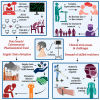Artificial Intelligence in Pharmaceutical Technology and Drug Delivery Design
- PMID: 37514102
- PMCID: PMC10385763
- DOI: 10.3390/pharmaceutics15071916
Artificial Intelligence in Pharmaceutical Technology and Drug Delivery Design
Abstract
Artificial intelligence (AI) has emerged as a powerful tool that harnesses anthropomorphic knowledge and provides expedited solutions to complex challenges. Remarkable advancements in AI technology and machine learning present a transformative opportunity in the drug discovery, formulation, and testing of pharmaceutical dosage forms. By utilizing AI algorithms that analyze extensive biological data, including genomics and proteomics, researchers can identify disease-associated targets and predict their interactions with potential drug candidates. This enables a more efficient and targeted approach to drug discovery, thereby increasing the likelihood of successful drug approvals. Furthermore, AI can contribute to reducing development costs by optimizing research and development processes. Machine learning algorithms assist in experimental design and can predict the pharmacokinetics and toxicity of drug candidates. This capability enables the prioritization and optimization of lead compounds, reducing the need for extensive and costly animal testing. Personalized medicine approaches can be facilitated through AI algorithms that analyze real-world patient data, leading to more effective treatment outcomes and improved patient adherence. This comprehensive review explores the wide-ranging applications of AI in drug discovery, drug delivery dosage form designs, process optimization, testing, and pharmacokinetics/pharmacodynamics (PK/PD) studies. This review provides an overview of various AI-based approaches utilized in pharmaceutical technology, highlighting their benefits and drawbacks. Nevertheless, the continued investment in and exploration of AI in the pharmaceutical industry offer exciting prospects for enhancing drug development processes and patient care.
Keywords: PBPK; QSAR; artificial intelligence (AI); dosage form testing; drug discovery; formulation; machine learning; pharmacodynamics; pharmacokinetics.
Conflict of interest statement
The authors declare no conflict of interest in this study.
Figures







References
-
- Chavda V.P., Vihol D., Patel A., Redwan E.M., Uversky V.N. Bioinformatics Tools for Pharmaceutical Drug Product Development. John Wiley & Sons, Ltd.; Hoboken, NJ, USA: 2023. Introduction to Bioinformatics, AI, and ML for Pharmaceuticals; pp. 1–18.
Publication types
LinkOut - more resources
Full Text Sources
Other Literature Sources

